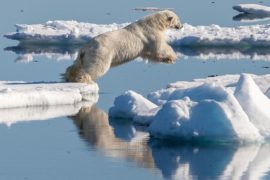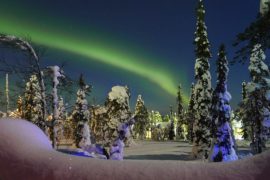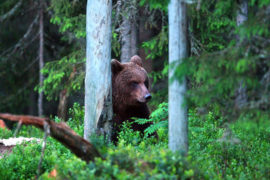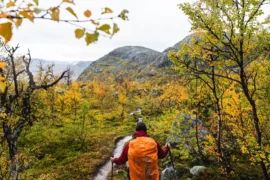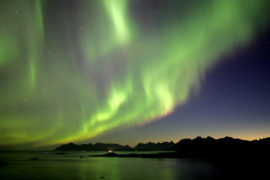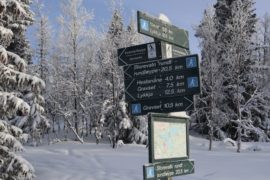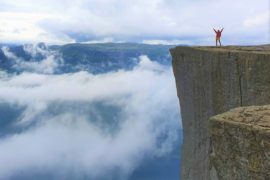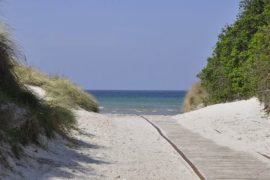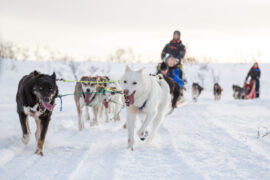With some of the best hiking in the Nordic region, Abisko National Park encompasses majestic mountains, alpine meadows, wooded valleys, gushing waterfalls, a 35-metre deep canyon and Scandinavia’s largest alpine lake.
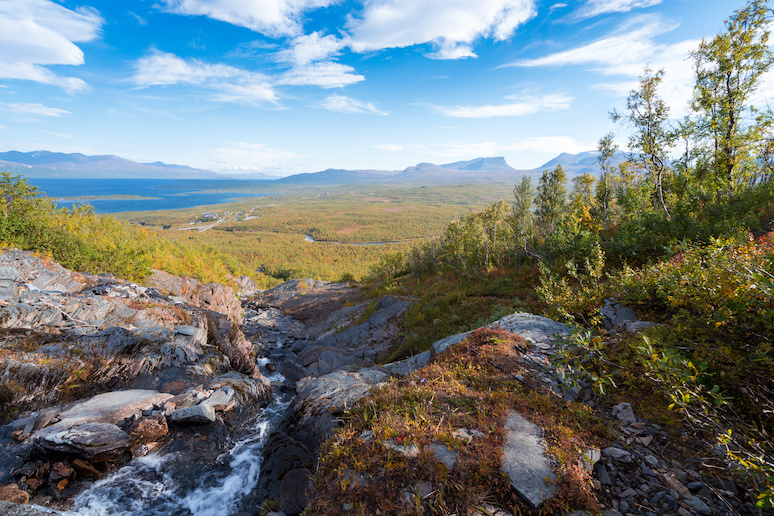
High up in the Arctic Circle, it’s a pristine and varied landscape with some great hiking trails including Sweden’s best-known hike, the long-distance Kungsleden.
For more on this 430-km long trek, which begins in Abisko and traverses the park, see our guide to hiking Kungsleden.
Where is Abisko?
Up in Swedish Lapland, close to the Norwegian border, the Abisko National Park stretches over 7,700 hectares, with Lake Torneträsk on its northern border.
The nearest city in Sweden is Kiruna, about 75 minutes drive away (or just over an hour by train), though the park is actually slightly nearer to Narvik in Norway (an hour by car, or 90 minutes by train).
Despite its remote location, it’s surprisingly easy to get to, with the main E10 running along its northern edge and Abisko Östra train station less than 1km from the park’s eastern border.
A direct train runs every night from Stockholm to Abisko, taking about 17 hours.
Alternatively, you can fly from Stockholm to Kiruna (see our Kiruna guide for details) and get the train from there to Abisko.
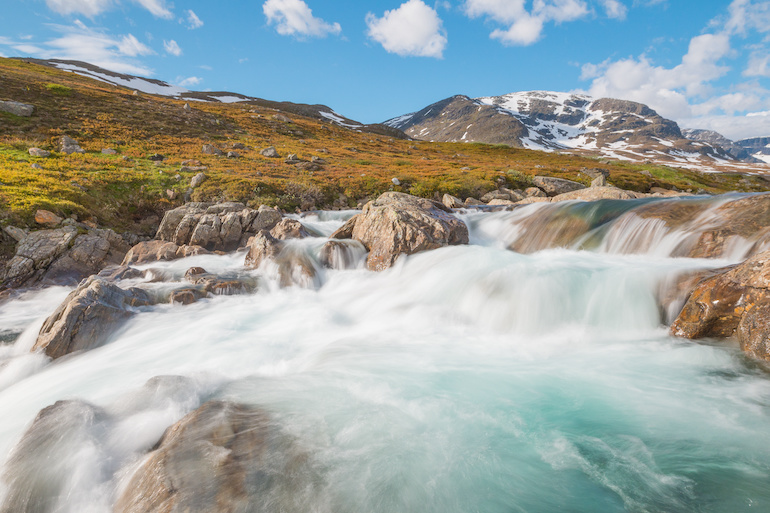
Is Abisko good for hiking?
The short answer is yes! Abisko has loads of marked hikes of all lengths and for all abilities.
Hardcore hikers can spend days walking across the park along the daddy of all trails, Kungsleden, while there are also trails for less experienced walkers that take in the park’s stunning scenery.
In terms of steepness, the park’s trails range from an easy 35-metre elevation gain, suitable for families and beginners, to a strenuous hike with a 12,327-metre elevation gain.
The park is also well-equipped for hikers, with Abisko Turistation providing accommodation, information, a restaurant and shop where you can buy hiking guides, food and buy or rent gear for your trip.
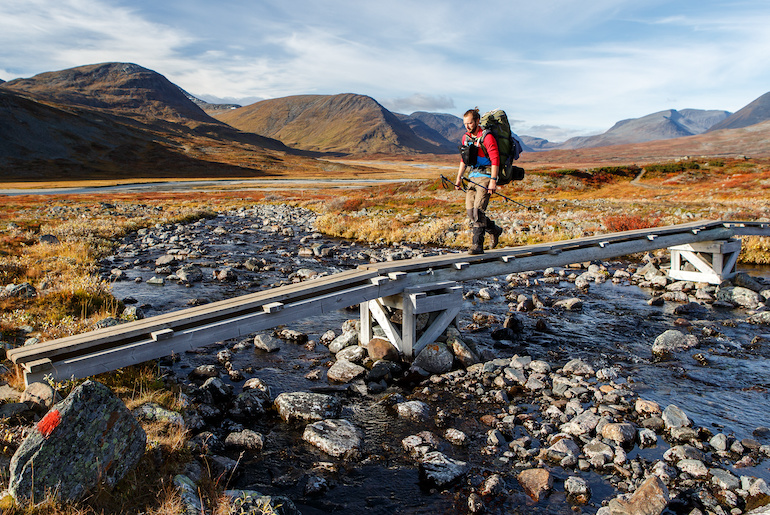
Guides are based at the Turistation, who can give advice and information if you’re heading out on your own, or you can hire a guide or book to go out on a guided hike with a group.
But one of the really special things about the park is its location. Because it’s high up in the Arctic Circle, you can hike beneath the midnight sun in summer and see the northern lights in winter.
Our top three hiking tours from Abisko
Going on a guided hike can be a great way of exploring the park without any of the hassle, especially if you’re a solo traveller.
You’ll also get to discover and learn about the park from an experienced guide, who knows the best places to go. So, here are our three favourite hiking tours in Abisko.
Top of our recommendations is this early-morning guided hike to Bjorkliden to watch the sun rise.
As well as stunning views of Abisko, Lake Torneträsk and the Lapporten mountains you’ll get to see the sky turn pink and red as the sun appears over the snowy mountains.
We also love this hike along the Kärkevagge Valley to Sweden’s cleanest and clearest lake Trollsjön, located 815 metres above sea level.
Your expert guide will point out reindeer, buzzards, hares and maybe even sea eagles, as you walk along the rocky valley and up to the lake.
And even if there’s heavy snow, you can still get out to explore the park on this guided snowshoe hike. Travel over the pristine snow in silence to immerse yourself totally in the Arctic atmosphere and clean air.
Hiking trails and routes
Abisko has loads of hiking trails, so your only real limitation is how long you’ve got and how fit you are!
Even the shortest and easiest hikes are impressive, but if you’re healthy and time is no object, you can walk for days in the park.
Short hikes
The Naturum, right beside Abisko Turiststation, is the local tourist office and has maps, books and loads of info on short hikes in the park.
Here are some of the most popular shorter walks, ranging from a couple of hours to a full-day.
A round hike via the Abiskojakka canyon
This well-marked trail starts from the Naturum on an easy gravel track to the Abiskojakka canyon. It follows alongside the river on wooden boardwalks to the Marmorbrottet marble quarry and former meditation site.
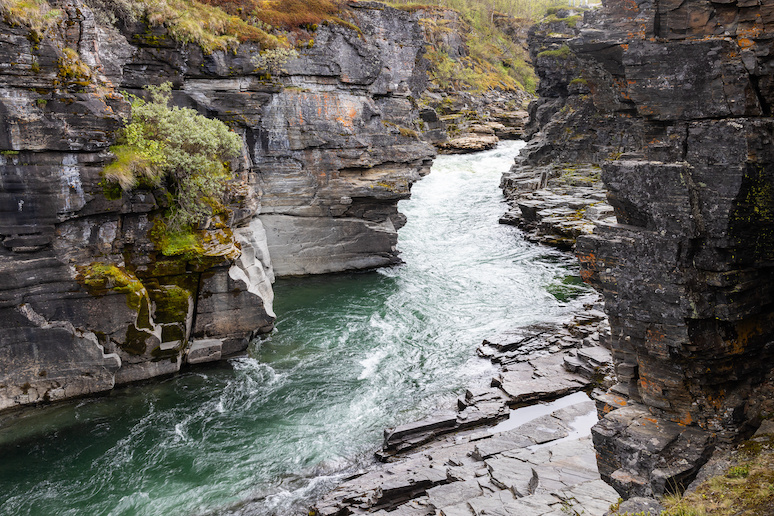
Here the path splits and you follow the orange nature trail to Lake Njakajaure then over heathland back to the Naturum.
There are picnic spots and a museum en-route, and there’s a detour down to Lake Torneträsk and a reconstructed Sami camp.
It’s an easy 5km circular hike that takes around 75 minutes, and is suitable for families and inexperienced walkers. It can be done all year round, but is at its best from July–September,
Hike to the Nissonjohkas suspension bridge
This hike starts by following Kungsleden southwards. After about 3km, you reach the Marmorbrottet from where it’s a further 1km uphill to a swaying suspension bridge.
On the other side of the bridge is a campsite, with shelter from the wind and areas for permitted campfires.
To get back back you need to return the way you’ve come past a viewpoint over the canyon.
This 8km hike is slightly more challenging that the previous one, and takes about two hours to do the return trip. The best time to do it is from March to September.
The Ridonjira nature path
This beautiful hike takes you along Abiskoeatnu to Ridonjira, then follows a stream uphill through a birch forest. The trail passes a row of small waterfalls, then crosses heathland and flowering meadows.
The path runs beneath the cable car and then heads steeply upwards towards the mountain station. From here, you can enjoy beautiful views over the national park and surrounding landscape before heading back down the way you came.
Although it’s only 6km there and back, this is considered a challenging hike with an elevation gain of almost 550m, and will take around three hours.
If you want a shorter walk you can go back down in the cable car. Or, to extend the walk, follow the red markers for a further hour or so up to the top of Njullás, for great views from a height of 1169 metres.
The trail can only be tackled in summer, from June to early October, due to the risk of avalanches.
Hike to Kårsafallen falls
The hike to the Kårsafallen waterfalls is a moderately demanding route that passes through birch forest, pine forest and on boardwalks over beautiful marshland.
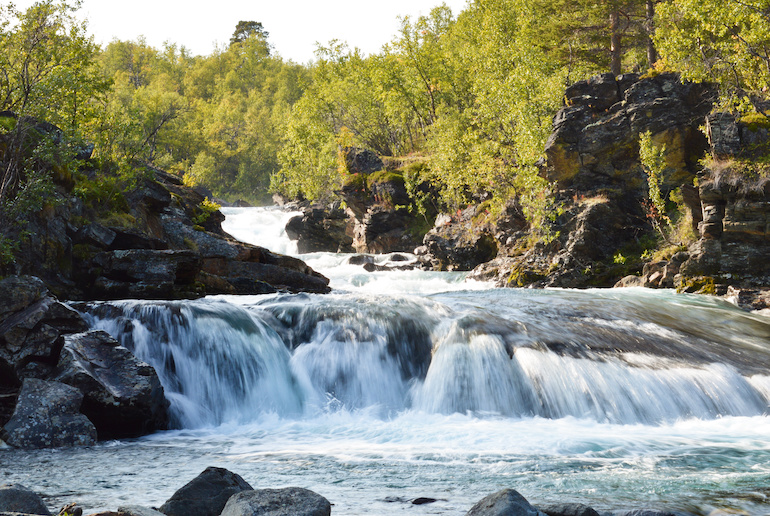
In summer, you should look out for capercaillie and Siberian jays.
The trail is marked with purple signs towards Kårsavagge. It is about 8.5km there and back, and takes just over two hours to walk.
Longer hikes
There are plenty of longer day hikes too that take in some beautiful parts of the park.
You can follow a trail to Kårsavagge in the western part of the park, or head southeast to Baddusdievva/Paddus, which is in the same direction as Lapporten/Cuonavaggi.
However, the most famous trail is Kungsleden which runs from Abisko south through the entire national park to Kebnekaise.
To tackle this, or any other multi-day hike, you’ll need to stay overnight in one of park’s designated campsites or at one of the STF mountain refuge huts.
Most of the longer hikes are summer-only: check this useful website to find out when the trails are open or closed and when they are at their most busy.
Kungsleden
This famous long-distance hiking trail starts in Abisko and its first 100km or so run through the park.
Abisko to Kebnekaise is generally considered to be the most dramatic section of Kungsleden, with the trail going over its highest point, the 1105 metre-high Tjäktja Pass.
The landscape is varied with wide open grasslands, fast-flowing rivers, birch forests and lakes, as well as rolling hills and barren mountainscapes. Eagles soar overhead and reindeer can often be seen grazing.
The Abisko section of Kungsleden is around 105km long and most people take six or seven days to walk it. Much of the hike is across wooden boards over marshlands, with the Tjäktja Pass being the most challenging section.
There are five STF mountain huts en route, with the STF Singi mountain cabin marking the end of this section of the trail.
Abiskojaure to Abisko to Lapporten then back to Abisko
You can also combine a couple of hikes to do a beautiful two-day walk that takes in mountains lakes, birch forests and river beaches.
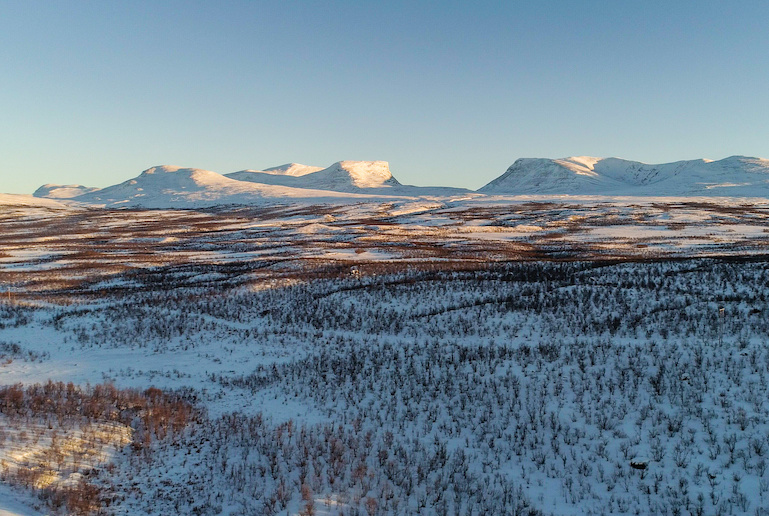
Starting from Abiskojaure, the first stage of this walk follows Kungsleden north to Abisko, a 15km hike that takes 4–6 hours.
You’ll need to spend the night in Abisko and the following day do the round walk from Abisko to Lapporten (27km; 7–8 hours), which takes in the remote mountain lake of Čuonjajavri and the beautiful Paddus viewpoint, a former Sami sacred site.
There’s STF accommodation at Abiskojaure and Abisko. The trail is at its best from June to September.
What can you expect to see in the park?
Although Abisko is one of Sweden’s most visited national parks, it’s still home to some rare species of flora and fauna.
It’s known for the pristine birch forests in the Abisko valley, but you can also spot Lapland alpine roses, polar flowers and several species of orchids.
In terms of wildlife, look out for the rare Nordic warbler, golden eagles, plover, moose, elk, lynx, mountain lemurs and ptarmigan.
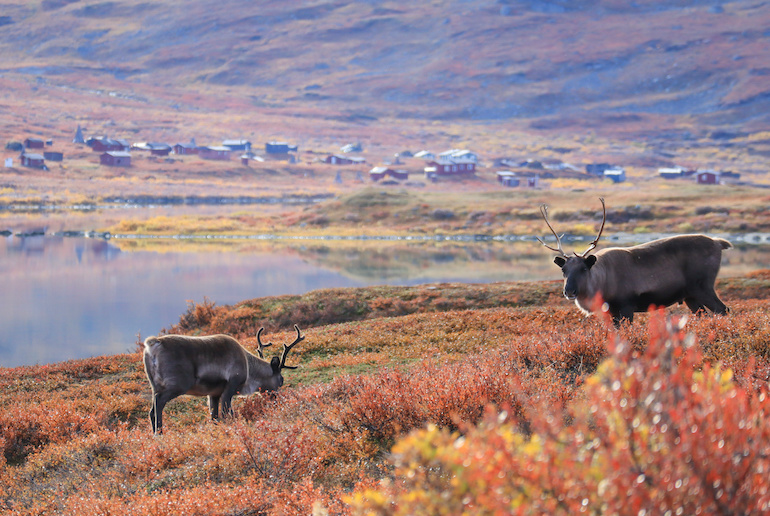
Bears and wolverine also live in the park, though it’s very unusual to come across anything more than their tracks.
The park’s many varied landscapes include Mount Njullás, the Abiskojakka canyon, Mount Lapporten, waterfalls and the Čuonjajavri mountain lake.
Safety and being prepared
The best way to ensure you have everything you need is to go on a guided hike, but if you are hiking independently, make sure you’re well prepared.
You should always follow the park regulations. There’s no camping, other than at designated STF camping places, which usually charge a small fee (though you may get access to a sauna thrown in!).
And you can only light fires at designated camp fire spots: barbecue grills are not allowed but gas stoves are. You’re not permitted to fish, but you can forage for mushrooms and berries – for private consumption only.
Essential hiking safety tips
- Check the weather conditions, and don’t go out if they are forecast to be bad.
- Try to hike with a partner or, at least, make sure someone knows where you are and when you are due back.
- Stick to the marked trails.
- Always take a good map and a compass.
- Don’t rely on a mobile phone as there’s no signal once you’re on the trails.
- Wear layers and come prepared for rain. Bring waterproofs, a woolly hat and gloves plus sunglasses and sunscreen. The weather can change quickly at this latitude!
- Bring water and plenty of snacks.
Where to stay before/after hiking
In our opinion, the best place to base yourself is the Abisko Turistation, which is in the park itself and the starting point for many hikes including Kungsleden.
It has a variety of accommodation from bunk-bed dorms to cottages and double rooms, plus a restaurant with good views of the lake.
And if you’re looking for something a little smarter, we like the cosy Abisko Mountain Lodge with comfortable rooms, a sauna and an excellent restaurant. It’s just outside the park, right by the train station.
See also:
Northern Lights tours in Abisko
What to see and do in Abisko
Seeing the northern lights in Abisko

